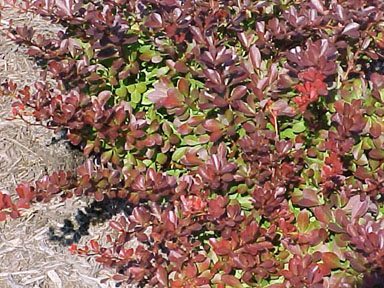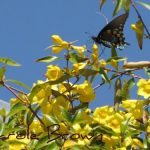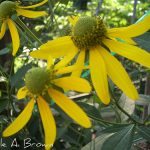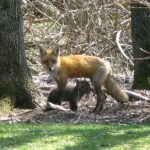I have a confession to make. Almost two decades ago, when I was a first time homeowner and newbie gardener, I actually bought and planted Japanese barberry (Berberis thunbergii). Not only did I not know any better, I was encouraged to buy it. I visited my local nursery and told them I was looking for a shade-tolerant, drought-tolerant, low-maintenance shrub that had to be deer resistant. The rest of the particulars really didn’t matter to me.
I was shown a few different cultivars and told any of them would work well in my garden. So I grabbed three purple-leafed shrubs (the exact cultivar long forgotten) and went home and planted them. And basically forgot about them for years because they thrived in my garden. Little did I know that by planting those shrubs, I was negatively impacting the local ecosystem and I was endangering my family.
While many gardeners know about Japanese barberry’s strongly invasive habits, at least 20 states have reported it be invasive, many gardeners may not realize that the presence of Japanese barberry has been linked to an increased risk for Lyme disease.
A multi-year study, taking place in Connecticut, is looking at the relationship between Japanese barberry (Berberis thunbergii), white-tailed deer, white-footed mice and blacklegged ticks. The results were recently released from the first two years of the study and are a bit surprising. In essence, the study found the larger the number of this plant in an area, the higher the incidence of Lyme disease carrying ticks.
Among the study’s early conclusions:
• White-tailed deer do not browse Japanese barberry, helping it to outcompete native shrubs.
• Dense stands of Japanese barberry provide favorable habitat for all life stages of blacklegged ticks. As ticks mature, they require host mammals of increasing size.
• Larval blacklegged ticks feed primarily on small host mammals, white-footed mice are a favorite. Several characteristics of Japanese barberry, including early leaf-out, dense thorns and an a wealth of fruit, all combine to create an ideal habitat for mice that is free from predators and has abundant food.
• Mature Japanese barberry is the perfect height for questing adult ticks to attach themselves to deer as they pass by.
• Eliminating Japanese Barberry will decrease the number of blacklegged ticks which in turn will significantly reduce the risk of Lyme disease.
But the sad fact is that today, even here in Connecticut where Japanese Barberry is on the invasive plant list, a first time homeowner and newbie gardener who walks into a local nursery and asks for a shade-tolerant, drought-tolerant, low-maintenance shrub that has to be deer resistant will probably be pointed towards Japanese Barberry.
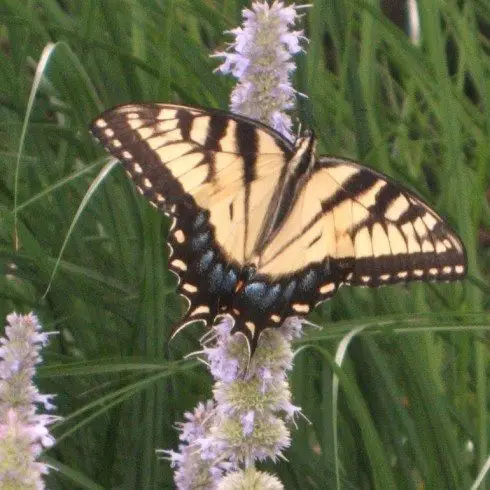
Agastache ‘Blue Fortune’ is one of the butterfly magnets in my garden
With a little education, we can help gardeners and plant sellers realize there are many native alternatives to Japanese barberry, including dwarf fothergilla (Fothergilla gardenia), highbush blueberry (Vaccinium corymbosum), New Jersey tea (Ceanothus americanus) and Virginia sweetspire (Itea virginica).
By simply choosing a native shrub that thrives in the same site conditions as Japanese barberry, we can create more wildlife habitat, reduce invasive species, protect local ecosystems and safeguard the health of ourselves and our families.
What’s your most hated plant? You know, the one that makes you cringe when you see it growing in someone’s garden? Or worse yet, for sale at a local nursery?
Leave Us Your Comments Below!
Click the Submit Your Comments button below to leave us your comments or questions!
More From Ecosystem Gardening:
Submit your review | |
I live in the Foothills of the Sierra Nevada Mountains. Growing zone 9. My most hated plant, which no one would buy, is Nut Sedge. Near impossible to kill and spreads easily. Hate Heavenly Bamboo and Pyracantha. Both are invasive and nearly impossible to kill. The birds eat the lovely pyracantha berries and spread the seeds all over and it has thorns to boot!
Most of the bushes in our southeastern New Hampshire yard were here when we bought it 13 years ago. The ones that have grown the best and look the loveliest are not good to have? Previous owners left us a stand of Euonymous (Burning Bush) in the side yard and what we believe to be Japanese Barberry along the front porch. Must we take them out?
Thanks for pointing this out. My most hated plant is Nandina. The berries contain cyanide, it will grow in almost any environment. I expect it to end up on noxious weeds list at some point but foe now it’s available in most nurseries and growing in so May gardens. Grrrr I hate it so berry much.
lyme disease invented by your uncle sam on plum island,by the mouth of lyme river. invasives thrive on disturbed,diseased,poisoned,damaged ground that we, carelessly, prepared for them.they hold the land that we've laid waste to and prepare it for the natives return. they thrive on toxic ground because they have anti-toxic compounds. This is why they are the best medicine on earth. 3 proven to stop lyme are barberry(root), honeysuckle, and knotweed. how "convenient" that they spread right along with the diseases we made. the forgiveness of nature. you've been trained to hate the wrong things.
I have a landscape design business and have to deal with liriope quite often here in Virginia. It is a very popular mulch bed plant. It is low maintenance, drought resistant, and virtually unkillable. It kills everything around it by strangling underground so homeowners have no idea that the liriope is the culprit. It sends out underground runners up to 2 feet and the roots go everywhere. If you try to pen it in it just gets thicker and thicker and then when you try to remove it well it is easier to dig up concrete.
I had 17 barberry plants in my yard ..all gone but one ..my yard infested and I have the new tick disease ALPHA GAL.. no cure..No one ever told me about this. the last plant will go . my disease is carried by the lone star tick. my life will never be the same
I have a small shrub that fits the description, except that it has no berries. Could this be okay to keep? There is a chance that the birds already ate all the berries, but, I probably would have noticed berries forming.
I cringe when I see Winged Euonymous (Burning Bush) and Japanese Barberry. It's maddening both are still being sold by retailers in CT.
That's easy, English Ivy! There are so many invasive plants that are bad but nothing smoothers and completely creates monocultures better than English Ivy. Sadly, it seems to be taking over every vacant property in the Southeast.
Good thing these plants are fiercely barbed, keeping warm blooded larger creatures, including people, away. Deer carry the ticks. Good thing they stay away from Barberry. Barberry root, bark and berries contains medicinal compounds which help in certain human diseases. Is it possible that the same habitat that is friendly to ticks is also friendly to Barberry? Ticks can't survive w/o blood. Barberry is not food for ticks or deer. All plants, leaves on the ground in fall make good places for ticks. I know. I live in the woods. We do not have any Barberry. We have a lot of deer, and ticks. I am a landscaper for a living. I have seen very few babies sprouting from the parent plants in the landscape, although I have seen a few, but only where a thick layer of decomposing bark surrounds the plants. The forest floor is a great habitat for ticks, with or without Barberry.
What you say about Japanese (or European) Barberry is true. Its also true that Berberis is a native genus. It is also true that all barberries provide hungry gap late winter food for birds and mammals. It is also true that its living barbed wire function of barberries protect not only mice and ticks but songbirds and young trees. In short dont plant it but dont make war on it either. Understand it and use it to help drive the diversity of your propery. For example, plant oaks or other native trees under the barberry to use its thorns to keep deer from devastating the young trees before they can get above the browse line. Or perhaps just leave the barberry if its providing shelter for songbirds near a birdfeeder. Above all avoid the herbicides which are much worse than the weeds.
In term of tick habitat, do two 3' to 4'tall barberry plants constitute a tick infestation? Are they a tick habitat. While they have been growing for more than 10 years they have shown no sign of spreading.
Japanese barberry for sure is at the top of my hate list. In looking for land to build my home in CT, I've seen stands of this that covers acres, and is very difficult to walk through as it's all tangled and covers all the rocks so thoroughly, when it's leafed out. Second on my list is likely Burning Bush, which while it looks nice and grows well, produces so many offspring that I've seen it covering both sides of some of the rural roads I drive on. State DEP's should prohibit nurseries from selling these plants. Plant scientists should work at developing sterile cultivars. And more articles on effective means to control these plants would be appreciated.

